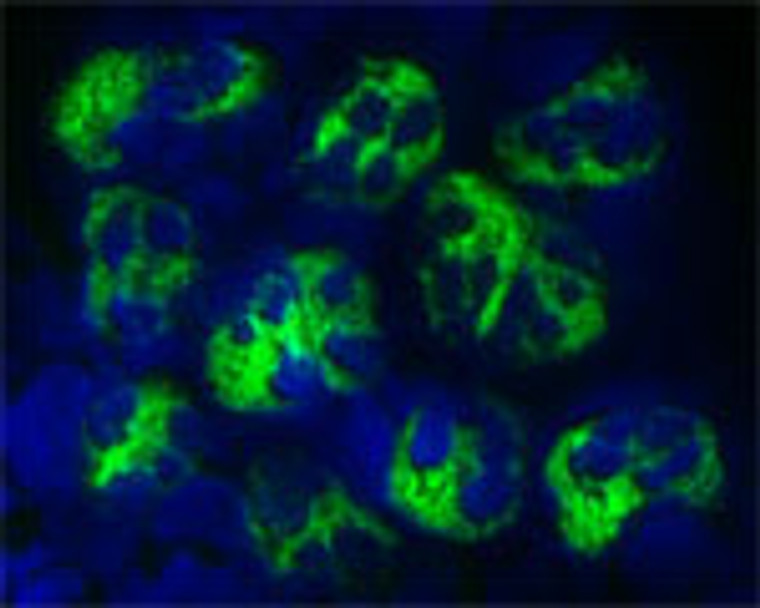| Host: |
NZ White Rabbit |
| Applications: |
IHC/WB |
| Reactivity: |
Human |
| Note: |
STRICTLY FOR FURTHER SCIENTIFIC RESEARCH USE ONLY (RUO). MUST NOT TO BE USED IN DIAGNOSTIC OR THERAPEUTIC APPLICATIONS. |
| Short Description: |
Nz White Rabbit polyclonal antibody anti-LL-37 is suitable for use in Immunohistochemistry and Western Blot research applications. |
| Clonality: |
Polyclonal |
| Conjugation: |
Unconjugated |
| Isotype: |
IgG |
| Formulation: |
Shipped as lyophilised. Reconstitute in 500 µl of sterile water. Centrifuge to remove any insoluble material. |
| Purification: |
Ammonium sulphate precipitation |
| Dilution Range: |
Use at a concentration of 10-50 µg/ml. The optimal working concentration should be determined by the end user. Not yet tested in other applications. |
| Storage Instruction: |
Maintain the lyophilised/reconstituted antibodies frozen at-20°C for long term storage and refrigerated at 2-8°C for a shorter term. When reconstituting, glycerol (1:1) may be added for an additional stability. Avoid freeze and thaw cycles. |
| Gene Symbol: |
CAMP |
| Gene ID: |
820 |
| Uniprot ID: |
CAMP_HUMAN |
| Specificity: |
Specific for Cathelicidin antimicrobial peptide. |
| Immunogen: |
A synthetic peptide from human Cathelicidin antimicrobial peptide conjugated to an immunogenic carrier protein has been used as the antigen. |
| Post Translational Modifications | The N-terminus is blocked. Proteolytically cleaved by proteinase PRTN3 into antibacterial peptide LL-37. Proteolytically cleaved by cathepsin CTSG and neutrophil elastase ELANE. Antibacterial peptide LL-37: Resistant to proteolytic degradation in solution, and when bound to both zwitterionic (mimicking mammalian membranes) and negatively charged membranes (mimicking bacterial membranes). After secretion onto the skin surface, the CAMP gene product is processed by a serine protease-dependent mechanism into multiple novel antimicrobial peptides distinct from and shorter than cathelicidin LL-37, such as peptides KR-20 (residues 151-170), LL-23 (residues 134-156), LL-29 (residues 134-162), KS-30 (residues 141-170), RK-31 (residues 140-170) and FF-33 (residues 138-170). The peptides act synergistically, killing bacteria at lower concentrations when present together, and maintain activity at increased salt condition. |
| Function | Antimicrobial protein that is an integral component of the innate immune system. Binds to bacterial lipopolysaccharides (LPS). Acts via neutrophil N-formyl peptide receptors to enhance the release of CXCL2. Postsecretory processing generates multiple cathelicidin antimicrobial peptides with various lengths which act as a topical antimicrobial defense in sweat on skin. The unprocessed precursor form, cathelicidin antimicrobial peptide, inhibits the growth of Gram-negative E.coli and E.aerogenes with efficiencies comparable to that of the mature peptide LL-37 (in vitro). Antibacterial peptide LL-37: Antimicrobial peptide that is an integral component of the innate immune system. Binds to bacterial lipopolysaccharides (LPS). Causes membrane permeabilization by forming transmembrane pores (in vitro). Causes lysis of E.coli. Exhibits antimicrobial activity against Gram-negative bacteria such as P.aeruginosa, S.typhimurium, E.aerogenes, E.coli and P.syringae, Gram-positive bacteria such as L.monocytogenes, S.epidermidis, S.pyogenes and S.aureus, as well as vancomycin-resistant enterococci (in vitro). Exhibits antimicrobial activity against methicillin-resistant S.aureus, P.mirabilis, and C.albicans in low-salt media, but not in media containing 100 mM NaCl (in vitro). Forms chiral supramolecular assemblies with quinolone signal (PQS) molecules of P.aeruginosa, which may lead to interference of bacterial quorum signaling and perturbance of bacterial biofilm formation. May form supramolecular fiber-like assemblies on bacterial membranes. Induces cytokine and chemokine production as well as TNF/TNFA and CSF2/GMCSF production in normal human keratinocytes. Exhibits hemolytic activity against red blood cells. Antibacterial peptide FALL-39: Exhibits antimicrobial activity against E.coli and B.megaterium (in vitro). Antibacterial peptide KR-20: Acts synergistically with peptides KS-30 and KR-31, killing bacteria such as S.aureus, E.coli and C.albicans at lower concentrations when present together, and maintains activity at increased salt condition. Does not have the ability to stimulate CXCL8/IL8 release from keratinocytes. Antibacterial peptide LL-23: Poorly active (MIC > 150 uM) against E.coli strain K12. Is able to induce the pro-inflammatory cytokine TNF/TNFA or the chemokine CCL2/MCP1. Antibacterial peptide LL-29: Moderately antibacterial. Antibacterial peptide KS-30: Moderately antibacterial. Acts synergistically with peptides KR-20 and KR-31, killing bacteria such as S.aureus, E.coli and C.albicans at lower concentrations when present together, and maintain activity at increased salt condition. Does not have the ability to stimulate CXCL8/IL8 release from keratinocytes. Antibacterial peptide RK-31: Acts synergistically with peptides KS-30 and KR-31, killing bacteria such as S.aureus, E.coli and C.albicans at lower concentrations when present together, and maintain activity at increased salt condition. Does not have the ability to stimulate CXCL8/IL8 release from keratinocytes. Antibacterial peptide FF-33: Inhibits the growth of E.coli and B.megaterium and exhibits hemolytic activity against human red blood cells. |
| Protein Name | Cathelicidin Antimicrobial Peptide18 Kda Cationic Antimicrobial ProteinCap-18Hcap-18 Cleaved Into - Antibacterial Peptide Fall-39Fall-39 Peptide Antibiotic - Antibacterial Peptide Ll-37 - Antibacterial Peptide Kr-20 - Antibacterial Peptide Ll-23 - Antibacterial Peptide Ll-29 - Antibacterial Peptide Ks-30 - Antibacterial Peptide Rk-31 - Antibacterial Peptide Ff-33 |
| Database Links | Reactome: R-HSA-6798695Reactome: R-HSA-6803157 |
| Cellular Localisation | SecretedVesicleStored As Pro-Peptide In Granules And Phagolysosomes Of NeutrophilsSecreted In Sweat Onto Skin |
| Alternative Antibody Names | Anti-Cathelicidin Antimicrobial Peptide antibodyAnti-18 Kda Cationic Antimicrobial Protein antibodyAnti-Cap-18 antibodyAnti-Hcap-18 Cleaved Into - Antibacterial Peptide Fall-39 antibodyAnti-Fall-39 Peptide Antibiotic - Antibacterial Peptide Ll-37 - Antibacterial Peptide Kr-20 - Antibacterial Peptide Ll-23 - Antibacterial Peptide Ll-29 - Antibacterial Peptide Ks-30 - Antibacterial Peptide Rk-31 - Antibacterial Peptide Ff-33 antibodyAnti-CAMP antibodyAnti-CAP18 antibodyAnti-FALL39 antibodyAnti-HSD26 antibody |
Information sourced from Uniprot.org
12 months for antibodies. 6 months for ELISA Kits. Please see website T&Cs for further guidance







